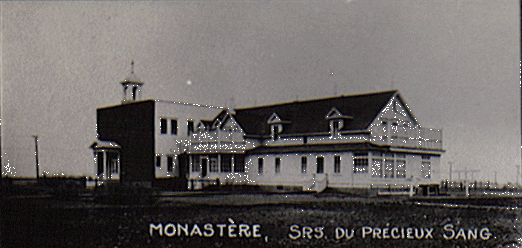

|
La communauté des Sœurs du Précieux Sang retrouve ses origines à Saint-Hyacinthe, Québec. Elle est fondée le 14 septembre 1861, par Mère Catherine-Aurélie-du Précieux-Sang (Caouette) et Mgr Joseph LaRocque. L’œuvre essentielle de cette communauté d’ordre contemplative d’origine canadienne c’est l’adoration du très précieux sang de Jésus et la glorification de Marie Immaculée dans sa conception. On y accomplit des exercices d’expiation et de réparation pour les outrages commis contre l’adorable Précieux Sang de Jésus qui a sauvé le monde. Par cette pratique constante jointe à celle de l’accomplissement de saintes œuvres on obtient des grâces de sanctification personnelles et des grâces dont a besoin la Sainte Église, en particulier les missionnaires dans leurs champs d’apostolat. C’est en 1926, soit le 14 janvier, que la communauté des Sœurs du Précieux Sang s’implanta à Gravelbourg dans la résidence du Docteur Maurice Gravel aux abords est de la ville. La Révérende Mère Marie-de-la-Rédemption (LaRocque), Sœur Marie-Ste-Cécile (Berthiaume), Sœur Marguerite-Marie (Geoffroy), Sœur Marie-du-Précieux-Sang (Cazelais), Sœur Imelda du St-Sacrement (Nepveu), Sœur Aurélie-de-Jésus (Forcier), Sœur Marie-Eustelle (St.Hyacinthe) et Sœur Marthe en sont les fondatrices. Le 19 janvier fut la bénédiction du nouveau monastère par Mgr Olivier-Elzéar Mathieu. Les Sœurs ne tardèrent pas de transformer quelque peu la résidence de celui-ci en construisant des annexes destinées à abriter le noviciat des Sœurs, l’imprimerie et l’atelier pour la confection des hosties. En 1928, les Sœurs procédèrent d’agrandir leur couvent tout spécialement par la construction d’une chapelle. Les Sœurs Adoratrices du Précieux-Sang eurent à témoigner des outrages lors de la fanatasmie qui se déferla dans la Province. Un fait écrit par l’archéviste de Gravelbourg : « En mai 1928, un hommage des plus solennels était rendu à la croix du Rédempteur en réparation d`une grave injure qu`elle reçu par le Ku Klux Klan, le 24 de ce mois de la Vièrge, tout près du Monastère, presque sous nos yeux. Il était 9 :30 p.m.et il y avait séance au Collège. Non loin, un bal organisé par des secteurs du fameux Klan. Quelques-uns dressèrent une croix de quinze pied, tirèrent dessus et mirent le feu.Elle était enveloppée, dit-on, de linges goudronnés et brûlait encore lorsque les invités du Collège sortirent de la séance. Le lendemain nous avions une procession en réparation. » En 1956, la résidence des Sœurs était dans un état précaire. Alors, la population du diocèse recueillit des fonds pour enfin restaurer et tranformer la vieille maison du Docteur Maurice Gravel dans un nouveau Monastère en 1957. (Ce qui est présentement, Evergreen Manor de Paul Larochelle.) Le cloître y continue sa vie de prière et réparation jusqu’à sa fermeture en 1975. Ces religieuses ont « missioné » par la prière et par l’adoration pendant tout prêt de cinquantes années. C’est l’abbé Adrien Chabot dans son histoire du diocèse qui les décrit comme des « anges gardiens » et comme les « ostensoirs » du diocèse. |
This community was founded in Saint-Hyacinthe, Québec on September 14th, 1861 by Reverend Mother Catherine Aurélie of the Precious Blood (Caouette) and Bishop Joseph LaRocque. The essential purpose of this first Canadian contemplative order is adoration to the Precious Blood of Jesus and the glorification of Mary Immaculate, atonement and the reparation for the ingratitude of men who refuse to accept the gift of salvation, the practice of offering the Blood of Lamb, the performing of pious works to obtain the personal graces and those needed by the church in general as well for missionary activity. On January 14th, 1926 this religious community arrived in Gravelbourg to take residence in the former home of Dr.Maurice Gravel that was situated on the eastern outskirts of the town. The founding Sisters are : Reverand Mother Marie-de-la-Rédemption (LaRocque), Marie-St-Cécile (Berthiaume), Marguerite-Marie (Geoffroy), Marie-du-Précieux-Sang (Cazelais), Imelda du St-Sacrement (Nepveu), Aurélie-de-Jésus (Forcier), Marie-Eustelle (St.Hyacinthe) and Marthe. On January 19th, Archbishop Olivier-Elzéar Mathieu blessed the new monastery. Gradually, the residence was transformed into various annexes that became a noviciate, a print shop and a room for the making of hosts. In 1928, a chapel was added to the Monastery. The Sisters of the Precious Blood were witnesses to the outrageous acts of fanaticism and bigotry that were unleashed in the Province. Records written by the town archivist : « In May, 1928 a most solemn hommage was given to the Cross of our Redeemer in reparation for the grievous acts of profanation committed by the Klu Klux Klan on the 24th day of May, in the vicinity of our monastery, almost before our very eyes. It was 9 :30 p.m.. An evening of entertainment was in progress in the auditorium of the Collège. Nearby was held a ball sponsored by members of the Klan. Some of them put together a fifteen foot cross, raised it up and set it afire. It was said that it had been wrapped with cloth soaked in tar and so it was still burning when the guests parted from the Collège. The next day, we held a procession of reparation… » In 1956, the population of the diocese was soon aware of the precarious condition that the residence was in. A campaign was launched and funds were raised for the renovations of the monastery in 1957. (Paul Larochelle’s Evergreen Manor) The cloister of sisters continued to lead their penitential
and prayerful life until the closing of the monastery, in 1975. Father
Adrien Chabot, in his story of the diocese, described these Sisters as
being the « guardian angels » and the « ostensoria »
of the diocese.
|